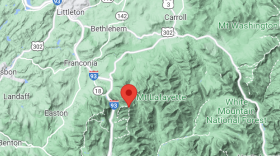Every other Friday, the Outside/In team answers a listener question about the natural world. This week’s question comes from Mariah in Lebanon, N.H., who asks: “Are there any effective solutions to wildlife collisions being explored in New Hampshire?”
Mariah said she reached out to the New Hampshire Department of Transportation last December, asking them to install a deer crossing sign where her mother saw a deer hit and killed by cars. The agency politely declined, she said, and told her there isn’t much evidence these signs actually reduce collisions.
If we're not putting up signs, then what are we doing?
Other states have experimented successfully with wildlife overpasses. These are bridges that span over a road or highway that allow wildlife to get safely across. But the challenge in a rural state like New Hampshire is that deer and moose will cross the road pretty much anywhere, so there are no obvious spots where overpasses should go.
On the bright side, there are over 20,000 spots in New Hampshire where roads go over a stream or a river, according to Sandra Houghton, a wildlife diversity biologist at the New Hampshire Fish and Game Department.
Some of these are bridges that wildlife can simply pass under. Others might, to your average driver, look like a normal road — but underneath, there’s a culvert, or a water tunnel. Granted, these aren’t always designed to be used by wildlife, but biologists like Houghton often try to get the state to swap in a wildlife-friendly version when it’s time to replace an old culvert.
Culverts are typically used by turtles, salamanders and fish. But sometimes larger animals use them, too. A culvert in Stratford was designed to mimic a natural river habitat that allows fish to pass through, but it also has bigger boulders that create a dry pathway that bobcats and black bears can use. Another culvert in Newmarket is even big enough for deer, according to Pete Steckler at The Nature Conservancy.
How can I help?
Houghton, with New Hampshire Fish and Game, recommended visiting a website called Taking Action for Wildlife, which has lots of suggestions — everything from donating land for habitat conservation, to reporting wildlife and roadkill sightings through a citizen science website run by the University of New Hampshire.
She also recommended getting involved in salamander crossing brigades organized by the Harris Center for Conservation Education in Hancock. Each spring, the center recruits volunteers to help salamanders, toads and frogs get across local roads to their breeding grounds in vernal pools.
Submit your question about the natural world to the Outside/In team. You can record it as a voice memo on your smartphone and send it to outsidein@nhpr.org or call the hotline, 1-844-GO-OTTER.
Outside/In is a podcast! Subscribe wherever you get yours.











